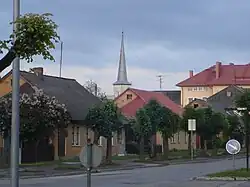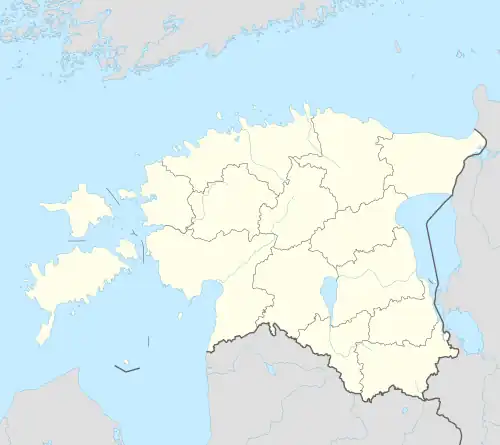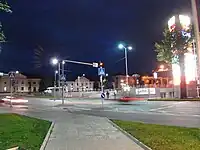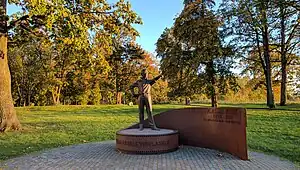Jõhvi
Jõhvi (German: Jewe) is a town in northeastern Estonia, and the administrative centre of the Ida-Viru County and Jõhvi Parish. The town is situated about 50 km west of the Estonia–Russia international border.
Jõhvi | |
|---|---|
 | |
 Jõhvi Location in Estonia | |
| Coordinates: 59°21′27″N 27°25′37″E | |
| Country | |
| County | |
| Municipality | |
| First historical record | 1241 |
| Town rights | 1 May 1938 |
| Area | |
| • Total | 7.62 km2 (2.94 sq mi) |
| Population (31.12.2021)[1] | |
| • Total | 10,482 |
| • Rank | 13th |
| • Density | 1,400/km2 (3,600/sq mi) |
| Ethnicity (2021) | |
| • Estonians | 34.7% |
| • Russians | 55.3% |
| • other | 10% |
| Time zone | UTC+2 (EET) |
| • Summer (DST) | UTC+3 (EEST) |
| Postal code | 41501-41599 |
History
Jõhvi was first mentioned as a village in 1241 in Liber Census Daniae when it was ruled by Denmark. Historical names of Jõhvi were Gewi and Jewe. In the 13th century a church was built there and Jõhvi became the centre of the local church parish.
On 1 May 1938, the government of Estonia upgraded the official status of Jõhvi from "borough" to that of an independent "town". During the period of Soviet administration (1944–1991), Jõhvi was administratively not a town, but a district of the city of Kohtla-Järve. In 2005, the town of Jõhvi was united with the parish of Jõhvi.
Demographics
During the period of the Soviet occupation, large numbers of immigrant workers from Russia and other parts of the former USSR were brought in to populate the rapidly growing city of Kohtla-Järve, including the then district of Jõhvi, which made Estonians a minority in the area.[2][3]
| Ethnicity | 1922[4] | 1934[5] | 1941[6] | 1959[7] | 2000[8] | 2011[9] | 2021[1] | |||||||
|---|---|---|---|---|---|---|---|---|---|---|---|---|---|---|
| amount | % | amount | % | amount | % | amount | % | amount | % | amount | % | amount | % | |
| Estonians | 1472 | 90.9 | 1874 | 91.7 | 1822 | 89.8 | 3838 | 36.5 | 4022 | 33.2 | 3718 | 34.5 | 3635 | 34.7 |
| Russians | 106 | 6.54 | 124 | 6.07 | 85 | 4.19 | - | - | 6482 | 53.5 | 6004 | 55.7 | 5797 | 55.3 |
| Ukrainians | - | - | 1 | 0.05 | - | - | - | - | 395 | 3.26 | 289 | 2.68 | 285 | 2.72 |
| Belarusians | - | - | - | - | - | - | - | - | 543 | 4.48 | 344 | 3.19 | 279 | 2.66 |
| Finns | - | - | 2 | 0.10 | 104 | 5.13 | - | - | 240 | 1.98 | 135 | 1.25 | 118 | 1.13 |
| Jews | 4 | 0.25 | 8 | 0.39 | 0 | 0.00 | - | - | 23 | 0.19 | 17 | 0.16 | 13 | 0.12 |
| Latvians | - | - | 4 | 0.20 | 4 | 0.20 | - | - | 39 | 0.32 | 21 | 0.19 | 32 | 0.31 |
| Germans | 15 | 0.93 | 14 | 0.69 | - | - | - | - | 34 | 0.28 | 16 | 0.15 | 24 | 0.23 |
| Tatars | - | - | 8 | 0.39 | - | - | - | - | 29 | 0.24 | 30 | 0.28 | 34 | 0.32 |
| Poles | - | - | 2 | 0.10 | 0 | 0.00 | - | - | 51 | 0.42 | 33 | 0.31 | 32 | 0.31 |
| Lithuanians | - | - | 0 | 0.00 | 1 | 0.05 | - | - | 39 | 0.32 | 27 | 0.25 | 28 | 0.27 |
| unknown | 1 | 0.06 | 2 | 0.10 | 3 | 0.15 | 0 | 0.00 | 122 | 1.01 | 17 | 0.16 | 39 | 0.37 |
| other | 22 | 1.36 | 4 | 0.20 | 9 | 0.44 | 6664 | 63.5 | 93 | 0.77 | 124 | 1.15 | 166 | 1.58 |
| Total | 1620 | 100 | 2043 | 100 | 2028 | 100 | 10502 | 100 | 12112 | 100 | 10775 | 100 | 10482 | 100 |
Climate
| Climate data for Jõhvi (normals 1991–2020, extremes 1926–present) | |||||||||||||
|---|---|---|---|---|---|---|---|---|---|---|---|---|---|
| Month | Jan | Feb | Mar | Apr | May | Jun | Jul | Aug | Sep | Oct | Nov | Dec | Year |
| Record high °C (°F) | 8.9 (48.0) |
8.1 (46.6) |
16.8 (62.2) |
26.0 (78.8) |
32.1 (89.8) |
33.1 (91.6) |
33.7 (92.7) |
34.6 (94.3) |
28.1 (82.6) |
19.7 (67.5) |
13.6 (56.5) |
10.9 (51.6) |
34.6 (94.3) |
| Average high °C (°F) | −2.3 (27.9) |
−2.4 (27.7) |
1.9 (35.4) |
9.5 (49.1) |
15.8 (60.4) |
19.6 (67.3) |
22.4 (72.3) |
21.0 (69.8) |
15.7 (60.3) |
8.5 (47.3) |
2.7 (36.9) |
−0.5 (31.1) |
9.3 (48.7) |
| Daily mean °C (°F) | −4.6 (23.7) |
−5.2 (22.6) |
−1.7 (28.9) |
4.5 (40.1) |
10.3 (50.5) |
14.6 (58.3) |
17.4 (63.3) |
15.9 (60.6) |
11.2 (52.2) |
5.5 (41.9) |
0.6 (33.1) |
−2.5 (27.5) |
5.5 (41.9) |
| Average low °C (°F) | −7.5 (18.5) |
−8.5 (16.7) |
−5.5 (22.1) |
−0.1 (31.8) |
4.3 (39.7) |
9.1 (48.4) |
11.9 (53.4) |
10.9 (51.6) |
7.0 (44.6) |
2.4 (36.3) |
−1.7 (28.9) |
−5 (23) |
1.4 (34.5) |
| Record low °C (°F) | −34.5 (−30.1) |
−36 (−33) |
−28.4 (−19.1) |
−18 (0) |
−6.5 (20.3) |
−2.5 (27.5) |
1.7 (35.1) |
−0.6 (30.9) |
−4.2 (24.4) |
−15.7 (3.7) |
−25.9 (−14.6) |
−41 (−42) |
−41 (−42) |
| Average precipitation mm (inches) | 45 (1.8) |
34 (1.3) |
36 (1.4) |
34 (1.3) |
50 (2.0) |
84 (3.3) |
77 (3.0) |
93 (3.7) |
67 (2.6) |
84 (3.3) |
64 (2.5) |
49 (1.9) |
717 (28.2) |
| Average precipitation days (≥ 1.0 mm) | 12 | 9 | 9 | 8 | 7 | 10 | 11 | 12 | 13 | 14 | 14 | 14 | 132 |
| Average relative humidity (%) | 90 | 88 | 80 | 72 | 68 | 73 | 76 | 80 | 84 | 87 | 90 | 91 | 82 |
| Source: Estonian Weather Service (precipitation days, 1971–2000)[10][11][12][13][14] | |||||||||||||
Gallery
 Jõhvi church
Jõhvi church Central square
Central square Jõhvi Gymnasium
Jõhvi Gymnasium Jõhvi promenade
Jõhvi promenade Jõhvi Concert Hall
Jõhvi Concert Hall Jõhvi Central Library
Jõhvi Central Library Jõhvi at night
Jõhvi at night Monument in memoriam of Kaljo Kiisk
Monument in memoriam of Kaljo Kiisk
References
- "RL21429: RAHVASTIK RAHVUSE, SOO, VANUSERÜHMA JA ELUKOHA (HALDUSÜKSUS) JÄRGI, 31. DETSEMBER 2021". Estonian Statistical Database (in Estonian).
- Duncan, W. Raymond (2019). Ethnic Nationalism And Regional Conflict: The Former Soviet Union And Yugoslavia. Routledge. ISBN 9780429715938.
- Kattago, Siobhan (2008). "Commemorating Liberation and Occupation: War Memorials Along the Road to Narva". Journal of Baltic Studies. 39 (4): 431–449. doi:10.1080/01629770802461225. S2CID 145001694.
- 1922 a. üldrahvalugemise andmed. Vihk IV, Viru maakond (tabelid). Eesti riikline statistika (in Estonian and French). Tallinn: Riigi Statistika Keskbüroo. 1924. pp. 12–13. hdl:10062/4451.
- Rahvastiku koostis ja korteriolud. 1.III 1934 rahvaloenduse andmed. Vihk II (in Estonian and French). Tallinn: Riigi Statistika Keskbüroo. 1935. pp. 47–53. hdl:10062/4439.
- Eesti Statistika : kuukiri 1942-03/04 (in German and Estonian). Tallinn: Riigi Statistika Keskbüroo. 1942. pp. 66–67.
- Katus, Kalev; Puur, Allan; Põldma, Asta (2002). Rahvastiku ühtlusarvutatud sündmus- ja loendusstatistika: Ida-Virumaa 1965-1990. Sari C (in Estonian and English). Tallinn: Eesti Kõrgkoolidevaheline Demouuringute Keskus. pp. 31–32. ISBN 9985-820-66-5.
- "RL222: RAHVASTIK ELUKOHA JA RAHVUSE JÄRGI". Estonian Statistical Database (in Estonian).
- "RL0429: RAHVASTIK RAHVUSE, SOO, VANUSERÜHMA JA ELUKOHA JÄRGI, 31. DETSEMBER 2011". Estonian Statistical Database (in Estonian).
- "Climate normals-Temperature". Estonian Weather Service. Retrieved 14 February 2021.
- "Climate normals-Precipitation". Estonian Weather Service. Retrieved 14 February 2021.
- "Climate normals-Humidity". Estonian Weather Service. Retrieved 14 February 2021.
- "Kliimanormid-Sademed, õhuniiskus" (in Estonian). Estonian Weather Service. Archived from the original on 22 February 2012. Retrieved 14 February 2021.
- "Rekordid" (in Estonian). Estonian Weather Service. Retrieved 19 March 2021.
